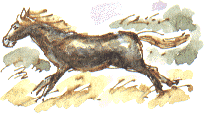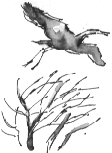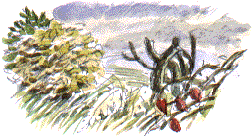 |
Good FencesSunday, 7th October 2001, West Yorkshire |
![]()
![]()
![]()
![]()
![]()
![]() This Month
Rocks
History
Workshop
Links
Home Page
This Month
Rocks
History
Workshop
Links
Home Page
![]()
 TEN OR FIFTEEN years ago, when a party from the British Trust for Conservation Volunteers came to lay our garden Hawthorn hedges, we were told that the old hawthorns between us and the meadow were too old, too thick, to lay.
TEN OR FIFTEEN years ago, when a party from the British Trust for Conservation Volunteers came to lay our garden Hawthorn hedges, we were told that the old hawthorns between us and the meadow were too old, too thick, to lay. Instead, our neighbour cut them down to the stumps for us with his chain-saw and we planted Hollies (seedlings that had sprung up in my mum's shrubbery) adding a fence (recycled from my father-in-law's old car port) to keep the ponies at bay in the meantime. This wasn't too successful and early one morning when Barbara was filling the kettle she became aware that she was being watched by Cinders, the Welsh pony, who had broken down the fence and made her way up our garden.
Instead, our neighbour cut them down to the stumps for us with his chain-saw and we planted Hollies (seedlings that had sprung up in my mum's shrubbery) adding a fence (recycled from my father-in-law's old car port) to keep the ponies at bay in the meantime. This wasn't too successful and early one morning when Barbara was filling the kettle she became aware that she was being watched by Cinders, the Welsh pony, who had broken down the fence and made her way up our garden. One misty morning we saw a Heron standing on this fence. Today, more than years later, the hollies have grown up, the fence is in need of replacement but, to our surprise, the hawthorns have also sprouted again from the old stumps. They have done so well that we now have to trim them back to give the hollies a fighting chance.
One misty morning we saw a Heron standing on this fence. Today, more than years later, the hollies have grown up, the fence is in need of replacement but, to our surprise, the hawthorns have also sprouted again from the old stumps. They have done so well that we now have to trim them back to give the hollies a fighting chance.Hedge-laying
 The younger hawthorns between ourselves and our neighbour's gardens were at a perfect stage for laying. This traditional process of management involves cutting away the base of the stem of each hedgerow shrub until it is possible to bend it over at about 45 degrees. Posts are hammered into the ground at intervals of a couple of yards or so. The stems are woven between these to create a stock-proof barrier.
The younger hawthorns between ourselves and our neighbour's gardens were at a perfect stage for laying. This traditional process of management involves cutting away the base of the stem of each hedgerow shrub until it is possible to bend it over at about 45 degrees. Posts are hammered into the ground at intervals of a couple of yards or so. The stems are woven between these to create a stock-proof barrier.
![]()
Richard Bell,
wildlife illustrator
E-mail; 'richard@willowisland.co.uk'
![]() Next page
Previous page
This day last year
This month
Nature Diary
Home Page
Next page
Previous page
This day last year
This month
Nature Diary
Home Page
![]()